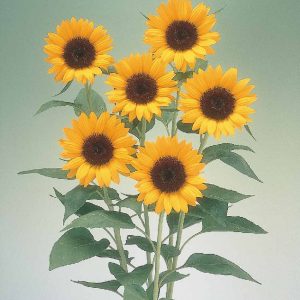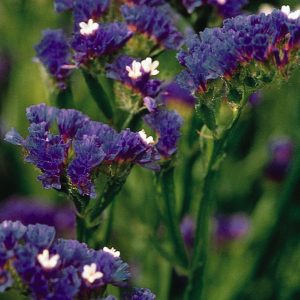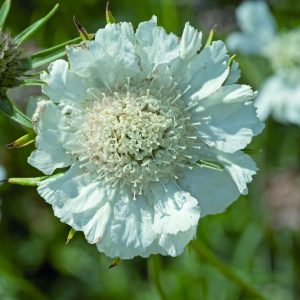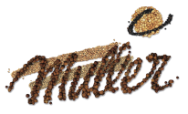GrowerFacts
Dill Herb Fernleaf
(Anethum graveolens)
Germination
• Time of radicle emergence (4-7 days)
• Soil temperature 68-72°F (20-22°C).
• Keep media evenly moist but not saturated.
• Do not cover or bury the seed.
• Light at 100-400 foot-candles may be beneficial for germination.
• Soil pH 5.5-5.8 and soluble salts (EC) less than 0.75 mmhos/cm (2:1 extraction).
• Dill is very sensitive to high salts, particularly high ammonium, during germination.
• Keep ammonium levels less than 10 ppm.
• Maintain soil pH 5.5-5.8 and EC less than 1.0 mmhos/cm.
• Increase feed to 100 150 ppm N from 20 10 20 alternating with 14 0 14 or other calcium/ potassium nitrate fertilizer.
• Gradually increase light intensity to 1000-1500 foot-candles.
• Fertilize every 2 3 irrigations.
• If 15-0-15 is used supplement with magnesium 1 2x during this stage, using magnesium sulfate (16 oz/100 gal) or magnesium nitrate. Do not mix magnesium sulfate with calcium nitrate as precipitate will form!
• Use DIF whenever possible, especially the first 2 hours after sunrise, to control plant height.
• Chemical growth regulators cannot be used on dill.
Plug production
STAGE 1 Time of radicle emergence (4-7 days)
• Soil temperature 68-72°F (20-22°C).
• Keep media evenly moist but not saturated.
• Do not cover or bury the seed.
• Light at 100-400 foot-candles may be beneficial for germination.
• Soil pH 5.5-5.8 and soluble salts (EC) less than 0.75 mmhos/cm (2:1 extraction).
• Dill is very sensitive to high salts, particularly high ammonium, during germination.
• Keep ammonium levels less than 10 ppm.
STAGE 2 Stem and cotyledon emergence (5-8 days)
• Soil temperature 68-72°F (20-22°C).
• Reduce moisture levels once radicle emergence occurs! Allow the soil to dry out slightly before watering for best germination and rooting.
• Gradually increase light levels to 500-1000 foot- candles.
• Keep soil pH 5.5-5.8 and EC less than 0.75 mmhos/cm.
• Keep ammonium levels less than 10 ppm.
• Begin fertilizing with 50 75 ppm N from 14 0 14 or a calcium/potassium nitrate feed once cotyledons are fully expanded.
• Alternate feed with clear water.
• Irrigate early in the day so foliage is dry by nightfall to prevent diseases.
STAGE 3 Growth and development of true leaves
(14-21 days)
• Soil temperature 65-68°F (18-20°C).
• Allow the soil to dry thoroughly between irrigations but avoid permanent wilting to promote root growth and control shoot growth.
STAGE 4 Plants ready for transplanting or shipping (7 days)
• Soil temperature 62-65°F (17-18°C).
• Allow soil to dry thoroughly between irrigations.
• Gradually increase light intensity to 1500-2500 foot-candles.
• Maintain soil pH 5.5-5.8 and EC less than 0.75 mmhos/cm.
• Fertilize with 14 0 14 or calcium/potassium nitrate feed at 100 150 ppm N as needed.
• If not potted up once established in the cell pack, dill will flower within 10 weeks.
Growing On to Finish
TEMPERATURE
Night: 55-60°F (13-16°C) Day: 60-65°F (16-18°C) LIGHT
Maintain light levels at 3000-5000 foot-candles while maintaining moderate temperatures.
MEDIA
Use a well-drained, disease-free soil-less medium with a medium initial nutrient charge and a pH 5.5-6.2.
FERTILIZATION
Fertilize every other irrigation with 15-0-15 alternating with 20-10-20 at 150-200 ppm nitrogen.
Maintain medium electrical conductivity around 1.0
mmhos/cm (using 1:2 extraction).
CONTROLLING HEIGHT
Once plants are rooted to the sides of the containers they can be allowed to wilt prior to irrigation to provide some height control.
Height can also be controlled by withholding fertilizer, especially phosphorous and ammonium-form nitrogen.
Dill are responsive to day/night temperature differential
(DIF), and are shorter with a negative DIF.
Chemical growth regulators cannot be used on dill.
“Information copied from the breeder.
Muller will not accept any liability for failure and/or damage as a consequence of incorrect and/or inexpert cultivation by or on behalf of the Buyer.”






